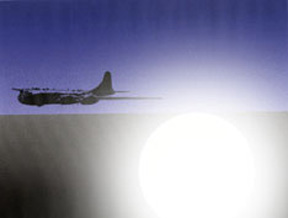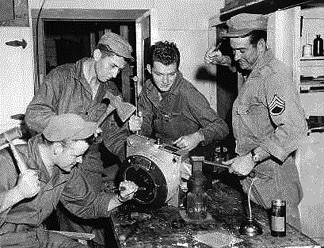|
of the RB-29 in the Korean War from An Aerial Photographer’s Point of View by Wayland Mayo |
|||||||||||
|
NIGHT PHOTOGRAPHY AND FINAL ANALYSIS NIGHT PHOTOGRAPHY |
|||||||||||
|
To keep from being discovered most rail movements in North Korea were made at night. Equipment coming from Vladisvostok Russia through Rashin, Korea, were made at night. We needed proof of this, so the RB-29 was sent to accomplish night photography of Rashin. The K-19 camera was installed, which used a photoelectric cell to trip it. The plane carried 40 magnesium bombs. When these exploded about 1500 feet above the ground the resulting flash triggered the photoelectric cell which tripped the camera.
|
|||||||||||
 |
|||||||||||
| Results were quite good, but photographing Rashin was very dangerous, since it was only a short distance from Vladisvostok. Flights such as this, including bombing were considered by Truman to be provocative to the Russians and were discontinued. |
|||||||||||
|
One such flight on which I was the photographer produced such a reaction. After dropping our bombs, our RADAR man Capt. Ridge, notified us that several aircraft were flying out of Vladisvostok and headed our way. We were going full speed over the ocean back to Japan, and after many anxious moments they turned back. That ended either bombing or photographing Rashin. Truman at this time was worried over Gen. MacArthurs aggressive actions and curtailed many such flights. Also the large buildup of Mig-15’s around Sinuiju and the Yalu was taking its’ toll on the B-29’s.
There were many other variations of camera setups on different planes for different purposes. Some planes were modified to carry long focal length cameras, as well described by Bill Welch in this website. There was also a provision for but seldom used camera station in the aft unpressurized section near the APU and in front of the lower aft turret. FINAL ANALYSIS The cameras used in the Korean War are now real antiques. Mapping companies today use distortion free lenses, gyroscopic controlled mounts, GPS for determining flight lines and coordinates, and contour maps are made on analytical plotters instead of analog. Even so, the quality of the photos taken in Korea by the RB’s were more than adequate for their intended purposes. That purpose was Surveillance and Bomb Damage Assessment. |
|||||||||||
| Members of the flight crews, who were closely involved with camera operation, maintained a working relationship with the camera repair technicians in the shops the squadron and base shop facilities. Here we see (L to R) Bill Welch, Wayland Mayo, (unknown) and Sgt. Culpepper fine tuning one of Tiger Lil’s cameras. |
|||||||||||
 |
|||||||||||
|
“Images, Impressions and Applications of the RB-29 in the Korean War from An Aerial Photographer’s Point of View” by Wayland Mayo If, for any reason you wish to be in touch, his e-mail address is “Wayland Mayo” <Koreavetmayo@worldnet.att.net> End of Chapter 05 — End of this Story Chapter — 01 — 02 — 03 — 04 — 05 Introduction — Table of Contents Home - Contact Us - Cold War Hist. - 91st SRS Hist. - Stardust 40 Mission Story |
|||||||||||